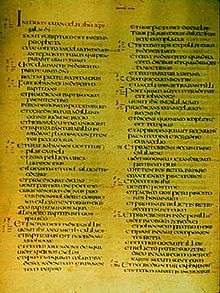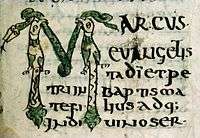Vulgate manuscripts
The Vulgate (/ˈvʌlɡeɪt, -ɡət/) is a late-4th-century Latin translation of the Bible that was to become the Catholic Church's officially promulgated Latin version of the Bible during the 16th century, and is still used fundamentally in the Latin Church to this day.

History
The Vulgate exists in many forms. The Codex Amiatinus is the oldest surviving complete manuscript; it dates from the 8th century.
A number of early manuscripts containing or reflecting the Vulgate survive today. Dating from the 8th century, the Codex Amiatinus is the earliest surviving manuscript of the complete Vulgate Bible. The Codex Fuldensis, dating from around 545, contains most of the New Testament in the Vulgate version, but the four gospels are harmonized into a continuous narrative derived from the Diatessaron.
Alcuin of York oversaw efforts to make an improved Vulgate, which he presented to Charlemagne in 801. He concentrated mainly on correcting inconsistencies of grammar and orthography, many of which were in the original text. More scholarly attempts were made by Theodulphus, Bishop of Orléans (787?–821); Lanfranc, Archbishop of Canterbury (1070–1089); Stephen Harding, Abbot of Cîteaux (1109–1134); and Deacon Nicolaus Maniacoria (mid-12th century). The University of Paris, the Dominicans, and the Franciscans following Roger Bacon assembled lists of correctoria; approved readings where variants had been noted.[1] Many of the readings that were recommended were later found to be interpolations, or survivals of the Old Latin text, since medieval correctors commonly sought to adjust the Vulgate text into consistency with Bible quotations found in Early Church Fathers.
List of manuscripts
Stuttgart Vulgate
List of manuscripts with siglum from the Stuttgart Vulgate (officially known as Biblia Sacra iuxta vulgatam versionem):
New Testament

Identification
The list of manuscripts below is based on citations in Novum Testamentum Graece (NA27) and The Greek New Testament (UBS4). Each manuscript is identified first by its siglum (the first column, s., in the table), as given by the critical apparatus of the editions mentioned. These sigla are related to content, so are not unique. For example, the letter S refers to Codex Sangallensis 1395 in the gospels, but to Codex Sangallensis 70 in the Pauline epistles. So sigla need disambiguation. In the table below, this is done by providing a full name. Additionally, the standard unique serial number for each manuscript is provided. Taken together sigla, name and number provide unambiguous identification, and some further information regarding the content, history and relationship of manuscripts.
Sigla, names and numbers exist to serve different scholastic purposes. Sigla, in the context of reference to an original document, provide unique and concise identification of witnesses to the text of that original, suited to minimizing the space taken by citation in a critical apparatus. Names, on the other hand, normally refer to specific handwritten volumes (often including other text), either as originally bound or in their current form. Names are typically Latin, and can refer to the place of composition (Codex Sangallensis, "Book from St. Gall") or rediscovery (Stonyhurst Gospel), the current location (Liber Ardmachanus, "Book of Armagh"), a famous owner (Codex Bezae, "Theodore Beza's Book"), a volume's function (Liber Comicus, "The Lectionary"), or can even refer to physical characteristics of a volume (Codex Gigas, "The Huge Book" or Codex Aureus, "The Gold Book"). The Book of Mulling is also known as Liber Moliensis after the name of the scribe, as tradition has it.
It must also be observed that certain Latin NT manuscripts may present a mixture of Vulgate and Old Latin texts. For example, Codex Sangermanensis (g1 ) is Old Latin in Matthew, but Vulgate in the rest of the Gospels. Also, the text of John in Codex Veronensis is believed to be part Old Latin and part Vulgate.
List
| Sigla | Name | Approx. date | Content | Custodian | City, State | Country |
|---|---|---|---|---|---|---|
| A | Codex Amiatinus | 716 | Bible | Laurentian Library | Florence | Italy |
| C | Codex Cavensis | 850 | Gosp–Paul; Rev | Archivio della Badia della Santissima Trinità | Cava de' Tirreni | Italy |
| C | Codex Complutensis I | 927 | Bible | Bibl. Univ. Centr. 31 | Madrid | Spain |
| D | Codex Durmachensis | 650 | Gospels | Trinity College, Dublin | Dublin | Ireland |
| F | Codex Fuldensis | 541—46 | New Testament | Hochschul- und Landesbibliothek Fulda | Fulda | Germany |
| G | Codex Sangermanensis I | 850 | New Testament | BnF | Paris | France |
| I | — | 800 | Biblioteca Vallicelliana (in Italian) | Rome | Italy | |
| K | — | 850 | Paul | Baden State Library | Karlsruhe | Germany |
| L | Lectionarium Luxoviense | 700 | General | |||
| M | Codex Mediolanensis | 550 | Gospels | |||
| N | — | 450 | Gospels | Bibliothèque Municipale | Autun, Paris | France |
| P | — | 600 | Gospels | |||
| R | Codex Reginensis | 750 | Paul | Vatican Library | Vatican City | Vatican City |
| R | — | 600 | General | Biblioteca Capitolare | Verona | Italy |
| S | Codex Sangallensis 1395 | 450 | Gospels | Abbey of St. Gall | St. Gallen | Switzerland |
| S | Codex Sangallensis 2 | 750 | Acts; Rev | Abbey of St. Gall | St. Gallen | Switzerland |
| S | Codex Sangallensis 70 | 750 | Paul | Abbey of St. Gall | St. Gallen | Switzerland |
| S | Codex Sangallensis 907 | 750 | General | Abbey of St. Gall | St. Gallen | Switzerland |
| T | Codex Toletanus | 950 | Bible | National Library of Spain | Madrid | Spain |
| Z | Codex Harleianus | 550 | Gospels | British Museum | London | United Kingdom |
| Θ | Codex Theodulphianus | 950 | Bible | Bibliothèque nationale de France | Paris | France |
| Λ | Codex Legionensis | — | Acts–Rev | Basilica of San Isidoro | León | Spain |
| 11A | Cod. M. p. th. f. 67 | Gospels | University of Würzburg | Würzburg | Germany |
References
- Linde, Cornelia (2011). How to correct the Sacra scriptura? Textual criticism of the Latin Bible between the twelfth and fifteenth century. Medium Ævum Monographs 29. Oxford: Society for the Study of Medieval Languages and Literature. ISBN 9780907570226.
- Weber, Robert; Gryson, Roger, eds. (2007). "Index codicum et editionum". Biblia sacra : iuxta Vulgatam versionem. Oliver Wendell Holmes Library, Phillips Academy (5th ed.). Stuttgart: Deutsche Bibelgesellschaft. pp. XLIII–XLVIII. ISBN 978-3-438-05303-9.
External links
| Wikimedia Commons has media related to Vulgate manuscripts. |